If you’ve ever managed a sales team, you already know how expensive turnover can be. A new hire walks in full of potential—and walks out just months later. The reasons vary: burnout, lack of confidence, poor fit, or simply not seeing a future. But at the root of it all, one factor almost always shows up: inadequate training.
In industries where competition is tight and customer expectations are high, good onboarding isn’t optional—it’s survival. That’s especially true in automotive sales, where a rookie’s first 30 days can define their long-term performance.
So, how do companies move beyond “orientation week” and start building teams that actually stay? It starts with treating training not as a checkbox, but as an investment in long-term retention.
The Onboarding Gap That Costs You Talent
Most businesses assume training ends once the paperwork is done and the CRM login works. But studies consistently show that structured, ongoing training programs dramatically reduce turnover.
The first three months on the job are make-or-break for most employees. Without guidance, new hires quickly lose motivation—and that disengagement spreads. The worst part? Many of these departures happen before the company even breaks even on the cost of hiring them.
In sales, where daily rejection and pressure are part of the job, structure matters even more. A strong training foundation gives new hires direction, builds resilience, and sets performance expectations early.
Why Sales Requires a Different Kind of Training
Sales is a performance-based profession, but it’s also deeply human. Success isn’t just about memorizing scripts—it’s about reading people, adapting, and building trust.
That’s why traditional “one-size-fits-all” onboarding rarely works for sales teams. Instead, the best organizations combine skill-based learning (like lead handling or objection management) with contextual learning—real-world scenarios that reflect their specific market and customer base.
In automotive sales, for instance, it’s not enough to understand features or pricing. Reps must also grasp how buying habits differ between demographics, how financing impacts decision-making, and how digital leads convert differently from walk-ins.
Training that focuses on these subtleties prepares salespeople not just to sell—but to stay and grow.
Learning by Doing: Building Confidence Early
Confidence is everything in sales, and it develops fastest through practice—not lectures. That’s why immersive, experience-based training models outperform theory-heavy programs.
For example, AutoAlert’s structured automotive sales training for new hires offers a 30-day progression plan built around live coaching, hands-on roleplay, and measurable milestones. Instead of overwhelming newcomers with product specs on day one, it focuses on what actually drives results—understanding customer psychology, listening skills, and smart use of CRM tools.
This kind of step-by-step approach builds momentum early. When reps start seeing small wins in their first few weeks, their motivation spikes—and that confidence tends to stick long after training ends.
Technology Makes Coaching Scalable
In the hybrid era, in-person shadowing isn’t always practical. That’s where digital tools bridge the gap.
Sales enablement platforms, e-learning modules, and AI-based feedback systems can help managers personalize learning paths without adding extra workload. Interactive dashboards let leaders monitor progress, spot skill gaps, and tailor coaching accordingly.
For growing organizations, this technology-driven approach keeps onboarding consistent even as teams scale. Every hire gets the same structured support, ensuring no one falls through the cracks.
It’s not about replacing human mentorship—it’s about amplifying it.
Mentorship: The Secret Ingredient to Retention
Even the best digital training can’t replace real-world mentorship. Pairing new hires with experienced salespeople creates a direct line for feedback, confidence-building, and accountability.
Mentorship humanizes the learning curve. It gives rookies someone to turn to when deals fall through or scripts feel awkward. That sense of community is what transforms “a job” into “a career path.”
Organizations that integrate mentorship into onboarding see lower turnover, higher morale, and faster time-to-competency across the board.
Culture and Consistency Go Hand in Hand
Training shapes culture more than any memo ever could. When new hires see that learning is valued, they model that same curiosity long-term.
Companies that invest in their people early create ripple effects—higher morale, better teamwork, and more customer loyalty. Employees who feel supported during onboarding are more likely to support others later, creating a positive feedback loop of mentorship and retention.
In short, consistent training doesn’t just fill skill gaps—it builds belonging.
The Big Picture
Strong onboarding isn’t just about retention—it’s about creating a competitive advantage.
When you train well, you don’t just build better sellers—you build brand ambassadors who understand the product, the process, and the purpose behind every sale.
Over time, that kind of alignment creates consistency in customer experience, strengthens internal culture, and saves enormous recruiting costs. In an era where loyalty is rare, investing in people is the ultimate differentiator.
Because when new hires are set up for success, they don’t just perform better—they stay longer, grow faster, and bring others along with them.



